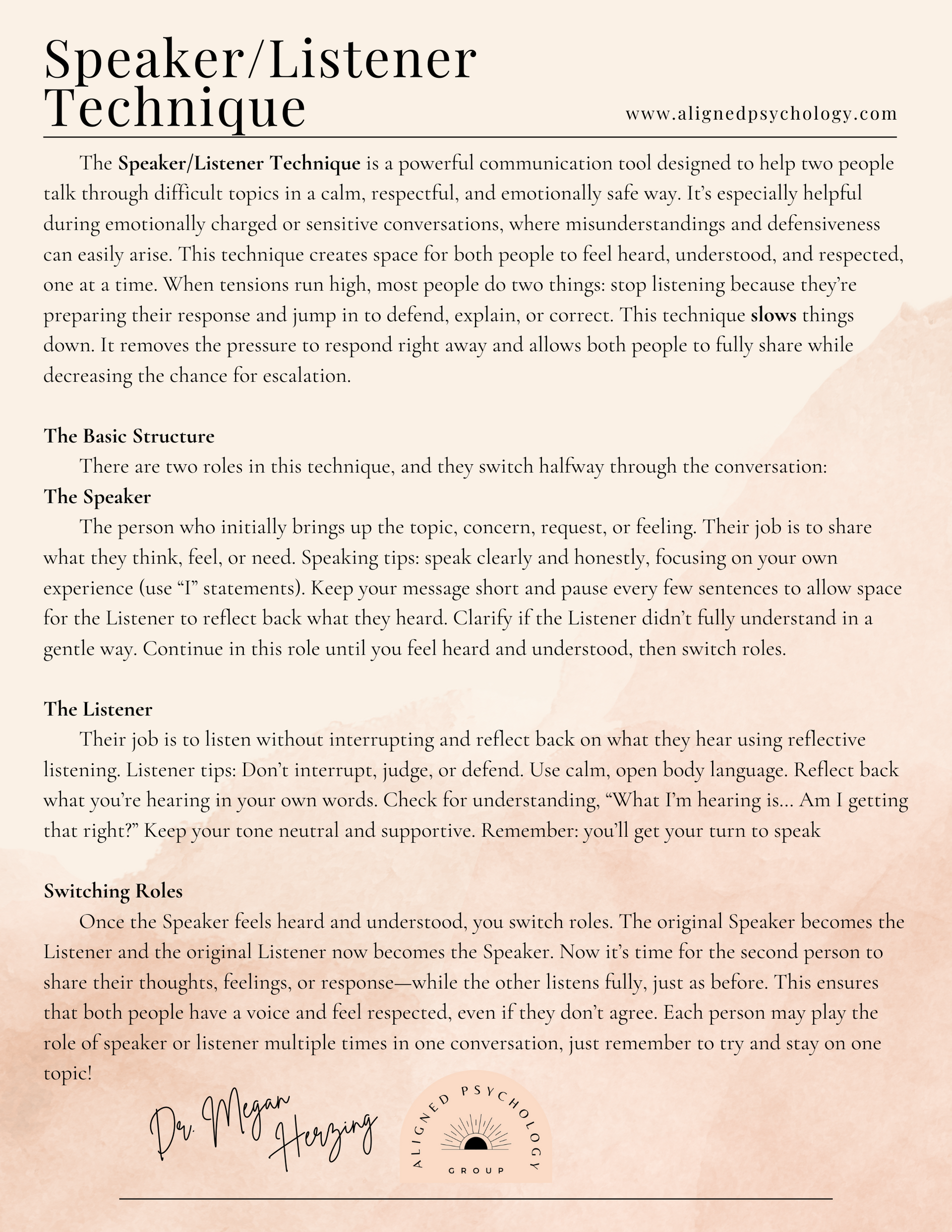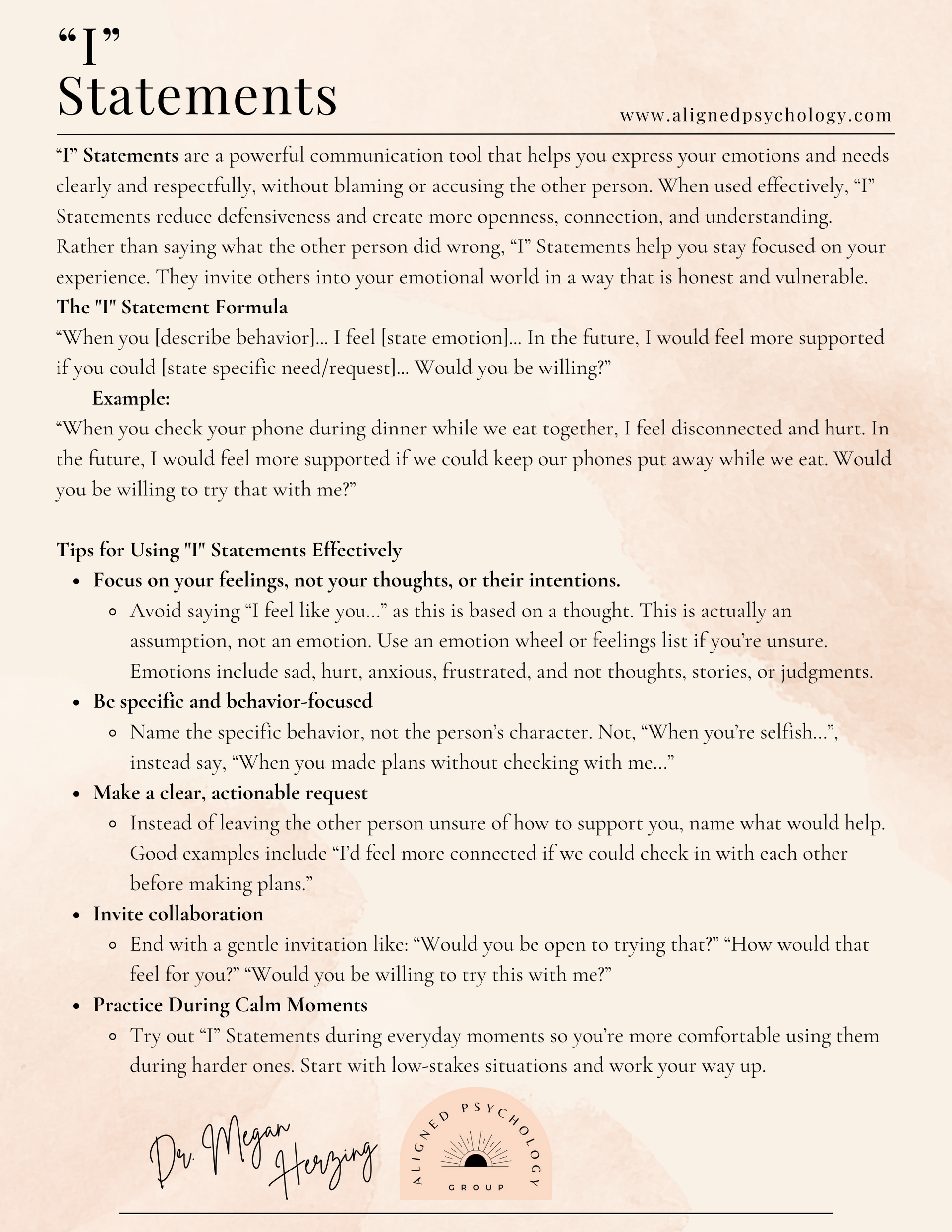Trauma Therapy Homework - Week 21
Week 21: (The Basics) Relationship Mini-Series
Communication 101
Welcome to Week 22 of your trauma therapy homework. This week we’re diving into something that shows up in every part of our lives—communication. Whether you’re talking to a partner, a friend, a coworker, a therapist, or yourself, the way you communicate makes a massive difference in how safe, seen, and understood you feel—and how safe, seen, and understood others feel with you.
Now, let’s be real: communication can be really hard. Especially if you’ve experienced trauma in relationships, it might feel unsafe to speak up, to be vulnerable, or to say the hard thing. You might also have learned communication styles that were rooted in survival—not connection. Maybe you grew up with yelling or stonewalling. Maybe you learned to people-please, shut down, or stay silent to keep the peace. If that’s you, you’re not alone. So many of us are learning a whole new way of relating—and that’s exactly what this week is about. Let’s start with the basics—simple, practical tools that help build safety, connection, and clarity in your conversations.

Reflective Listening
One of the most powerful tools in communication is also one of the simplest: reflective listening. Reflective listening is just what it sounds like—being a mirror. When someone shares something with you, instead of jumping in with your perspective, giving advice, defending yourself, or problem-solving, you reflect what you heard back to them. In your own words.
That might sound like:
- “So what I’m hearing is that you felt left out when I didn’t text you back yesterday. Is that right?”
- “You’re saying that you’re feeling overwhelmed with work and need more support at home. Am I getting that?”
This is not about repeating someone word-for-word. It’s about summarizing their message in a way that shows you’re truly listening. Then checking in: “Did I get that right?” or “Is that what you meant?” This helps the other person feel seen and gives them a chance to clarify if needed. We all want to feel understood. Reflective listening slows things down and builds trust. It’s a skill, and it takes practice, but it’s one of the most powerful ways to deepen connection.
Speaker/Listener Technique
Now let’s build on that with a technique called Speaker/Listener. This is a super helpful structure, especially for emotionally charged or difficult conversations. Here’s how it works: the person who brings up the topic (or concern, or request) becomes the Speaker. The other person is the Listener. The Listener’s only job is to reflect—no defending, no problem-solving, no arguing, no interrupting, no feedback. Just use reflective listening like a mirror and check in: “Did I hear that right?”
The Speaker needs to take time to pause after a few sentences so the Listener can reflect and the Speaker can clarify if something was misunderstood. Then the Speaker continues if they need to. You go back and forth as many times as needed until the Speaker feels heard and understood. You as the Listener can ask "Did you feel heard and understood? Is there anything else you want me to know?" Once the Speaker feels complete, the roles switch. Now the other person who was previously the Listener becomes the Speaker. And the same thing happens. In one conversation, you might be each be the Speaker and Listener 3 times. It doesn't need to just be one time. The important thing is to stay in your roles so that the Speaker can feel seen. This process creates space for both people to feel heard—fully. It slows things down. It helps prevent escalation. And it makes space for deeper understanding, rather than just reacting or trying to “win” the conversation.
Stick to One Topic per Conversation
When conversations get tough, especially in close relationships, it’s easy to fall into the trap of the “kitchen sink”—where every unresolved issue gets thrown into the mix. One minute you’re talking about forgetting to take the trash out, and suddenly you’re bringing up something from three years ago, plus five other grievances you haven’t said out loud yet. We get it. It’s hard to bring up conflict, and when you finally do, it can feel like now or never. But here’s the truth: trying to solve everything at once makes it harder to solve anything at all.
Instead, try to focus on one issue at a time. Be clear with yourself: What am I actually upset about right now? What’s the core of this? What is the thing we started talking about? Stick to that one thing. Let the conversation resolve—or at least reach a point of shared understanding on the single issue. You’ll be surprised how much more clarity, resolution, and healing can happen when you keep things simple and focused. You can always come back to another thing in a different conversation.

Using “I” Statements
Another tool that makes a huge difference in tough conversations is using I statements. Why? Because they keep the focus on your own experience, rather than blaming or accusing the other person. When people feel attacked, they go into defense mode. When people feel invited into your emotional world, they’re more likely to listen.
The formula looks like this:
When you [behavior], I feel [emotion]. In the future, I would feel supported if you [need/request]. Would you be willing? Let’s look at an example: “When you check your phone during dinner, I feel disconnected and unimportant. In the future, I would feel supported if we could keep phones away while we eat together. Would you be willing to try that with me?” That’s a whole different vibe than: “You’re always on your phone and it’s so rude!” I statements take responsibility for your emotions. They also make clear, kind requests—which increases the chances of real change. You’re not just venting or blaming. You’re inviting collaboration. The most important thing about I statements is to use actual emotion words, not thought words. For example "I feel you don't care" is actually a thought (an assumption), not a feeling. A feeling is "I feel disconnected. I feel sad. I feel unseen." Check the emotion wheel if you need help naming the feeling

The Positive Sandwich
Giving feedback or bringing up a tough issue is uncomfortable. Even when it’s necessary. That’s where the positive sandwich can help.
Here’s how it works: you start with something positive, then share the hard or uncomfortable thing, and end with another positive or connecting statement. It softens the delivery, builds emotional safety, and reminds the other person that the relationship matters more than the conflict.
For example: “I love you and I really appreciate how much effort you’ve been putting into our relationship lately. I wanted to share something that’s been on my mind—when you cancel plans last minute, I feel hurt and unimportant. I know that’s probably not your intention, but I wanted to be honest. I’m bringing this up because I care about us and want to keep growing together.” See how that feels different than just launching into a complaint? The key is genuine positivity—not fake flattery. You’re reminding the other person, “We’re on the same team.” That makes it easier to hear hard things—and stay connected in the process.
Getting Consent to Have the Conversation
Before jumping into any emotionally charged or important conversation, it’s important to check in with the other person and get their consent to talk. This might sound formal, but it’s actually one of the most respectful and trauma-informed things you can do. Giving someone a heads-up that the conversation may be difficult or personal—especially if it’s about your relationship—gives them the chance to prepare emotionally and mentally. It also increases the likelihood that they’ll be able to listen openly and respond thoughtfully. You might say something like, “There’s something important I want to talk about—it might be a little hard, and it’s about us. Is now a good time, or would another time work better for you?” By asking, you’re showing care, respecting their boundaries, and setting a foundation of mutual respect before the conversation even begins. They may have had a really difficult or stressful day at work. They may realize that they would feel more capable of listening tomorrow or on the weekend. Respect their choice and autonomy of when would be a good time for them.

Putting It All Together: A Sample Conversation Using the Tools
Let’s walk through an example of a conversation that uses all six of the communication skills we talked about—consent, reflective listening, speaker/listener, focusing on one topic, the positive sandwich, and I statements. Scenario: Alex and Jamie are in a relationship. Alex wants to talk about feeling hurt that Jamie hasn’t been making time for their weekly date nights.
Consent
Alex asks Jamie when would be a good time to have a difficult conversation about their relationship. She agrees tomorrow night will be a better time for her, as she has an easier work day and less responsibilities.
The next night's conversation:
Speaker/Listener Roles
Alex initiates the conversation and becomes the initial
Speaker. Jamie agrees to be the initial
Listener.
Alex (Speaker):
“I want to bring something up that’s been on my mind.
Positive Sandwich
First, I just want to say I really love you and appreciate how much you’ve been juggling with work lately. I have noticed how much effort you have been putting into our relationship.”
I statement
“That said, when you cancel our date nights, I feel really disappointed, hurt, and unimportant. I look forward to that time with you, and I miss it. I wanted to be honest about how it's been affecting me.”
End of Positive Sandwich
“I wanted to share it because I care about our relationship and I want to stay close. I feel more connected to you when we have our date nights.”
Jamie (Listener):
Reflective Listening
“Okay, so you’re saying that you feel hurt and disappointed when I cancel date nights, and it makes you feel less important. And you’re sharing this because you really care about us and want to keep feeling close. Did I get that right?”
Alex (Speaker):
“Yeah, that’s it. Thank you for hearing me.”
Jamie (Listener):
"Did you feel seen and heard? Is there anything more you need me to understand or reflect?"
Alex (Speaker):
"No, not for now. Thank you for listening."
Roles Switch – Now Jamie becomes the Speaker, and Alex is the Listener.
Jamie (Speaker):
“Thanks for bringing that up. I’ve been overwhelmed with deadlines and honestly, I didn’t realize how much canceling our date nights was affecting you. I really do care about our time together.”
Alex (Listener):
Reflective Listening
“You’re saying work has been really overwhelming and you didn’t realize how much it was impacting me, but you do care about our time. Is that right?”
Jamie (Speaker):
“Yes. I’m willing to work on being more intentional with our date nights.”
Alex (Listener):
"Do you feel heard and understood, or is there anything else you want me to know or listen to about this?"
Jamie (Speaker):
"I'm good. Would you like to be the Speaker again? Do you have more to share?"
Roll Switch
Alex (Speaker) :
I Statement with a request
“Yes please. That means a lot. In the future, it would help me if we could pick a backup day just in case the first one doesn’t work out. Would you be open to trying that?”
Jamie (Listener):
“Yeah, I’d love that. I am hearing you say that you would feel more supported if we have a backup date night planned if my work gets in the way of us doing our original planned night. Did I get that right?”
Alex (Speaker):
"Yes. Thank you for listening. I appreciate your teamwork in our relationship. I know I can come to you with issues and you create a safe space for these conversations. I love you."
Skill Recap:
Consent: Alex asked for consent on when to have a difficult conversation about the relationship
Reflective Listening: Both partners reflect and confirm understanding when in the Listener role
Speaker/Listener: One person speaks, the other only listens and reflects, and then they switch roles
One Topic: They stick to the one specific issue of canceled date nights
Positive Sandwich: Alex opens and closes with appreciation
I Statements: Alex shares feelings using emotional words (not thoughts) and requests using non-blaming language

Disclaimer
It's important to understand that these communication skills are designed to be used in safe, respectful relationships, not with people who are emotionally abusive, manipulative, or consistently harmful. Trying to use compassionate communication with someone who ignores your boundaries, uses your vulnerability against you, or refuses to engage in mutual respect can actually backfire. It may leave you feeling more confused, dismissed, or even unsafe. Communication is a two-way street, and no amount of skill can fix a relationship where one person is unwilling to take responsibility or act with kindness and respect. Safe people aren’t flawless—they may make mistakes and cause conflict—but they are willing to listen, take accountability, and grow with you. They don’t punish you for having needs or feelings. If you're questioning whether a relationship is safe enough to practice these communication tools, that’s a signal worth listening to. You might consider talking to a therapist or a trusted support person to help you sort through that dynamic. Your voice matters. And it deserves to be heard in places where it is honored, not harmed.
Final Thoughts
Communication is a skill. And if you didn’t learn healthy communication growing up, it makes total sense that it feels awkward, clunky, or even terrifying at first. But just like any skill, you can learn. You can practice. You can get better. The tools we covered this week—reflective listening, speaker/listener, sticking to one topic, the positive sandwich, consent, and I statements—aren’t about being perfect. They’re about building connection. They’re about creating space for real understanding. They’re also deeply trauma-informed. They slow things down. They increase safety. They help regulate the nervous system during vulnerable moments.
You deserve relationships where you can be honest and stay connected. Where you can say the hard thing without losing the relationship. Where you can listen with your full heart and feel listened to in return. This week, see if you can try one of these tools in a real conversation. Maybe with a friend, partner, coworker—or even just journaling to yourself. Start small. Notice how it feels. And remember: every time you show up with intention and care, you’re re-writing the story. You’re creating new patterns. You’re healing—not just yourself, but the way you connect with others. You’re doing brave work. Keep going.
FREE Downloadable Handouts
Click this LINK for free access to downloadable PDFs from the Trauma Therapy Homework Series. You’ll be directed to my Google Drive folder, where you can explore all the handouts created so far. You can choose between a digital format for easy viewing on your device or a printable version if you prefer a hard copy.
Here is a preview of this week's handout! Click the link above to get your own free pdf copy.





ABOUT THE AUTHOR
Dr. Megan
Megan Herzing PsyD, Licensed Professional Clinical Counselor, specializes in trauma therapy and creating a safe, supportive space for healing. She integrates evidence-based modalities, including EMDR, Internal Family Systems (IFS), somatic therapy, and Emotionally Focused Therapy (EFT), to address the mind-body connection and empower clients on their journey to wellness. With extensive experience treating complex PTSD, anxiety, attachment injuries, and dissociation, she believes in the power of self-compassion and authentic connection to facilitate lasting change. Drawing from her own healing journey, she brings empathy and lived experience to her work, honoring each client’s unique path toward growth and resilience.
Thank you for being part of a community of humans that deeply cares about healing.
We are honored that you stopped by and hope our resources will continue to bring value to your life.
We are accepting new clients in California, and referrals are always appreciated.












